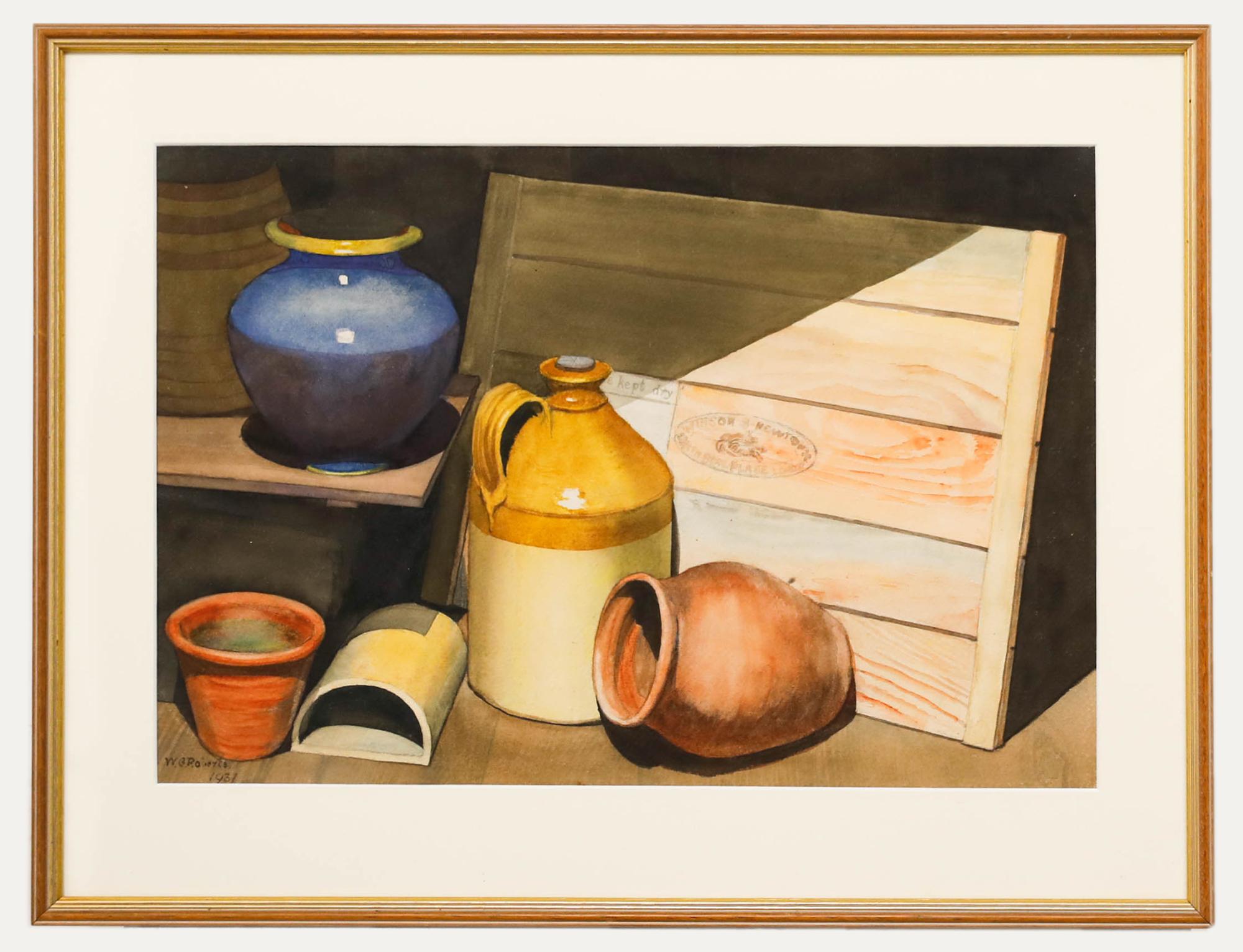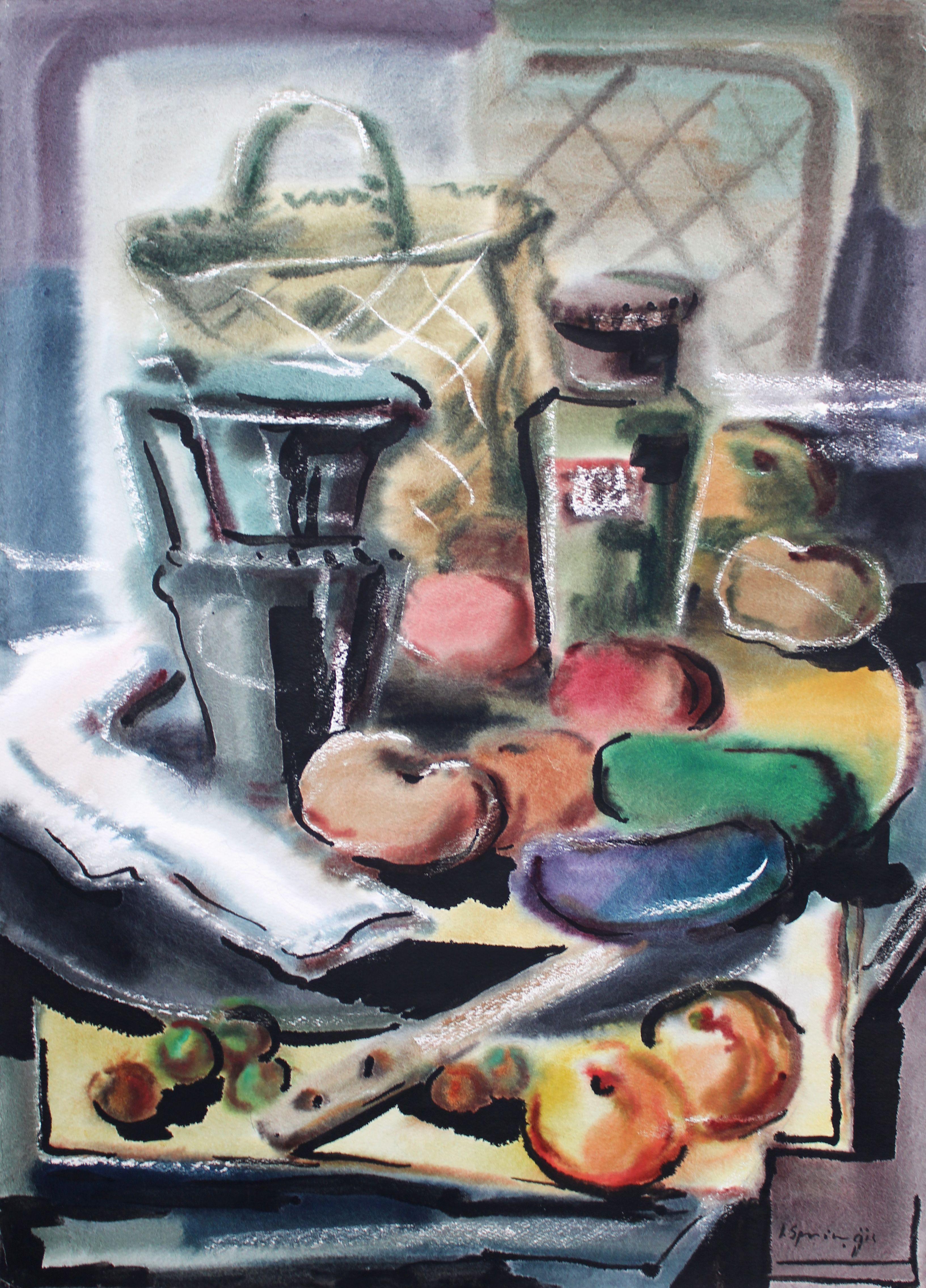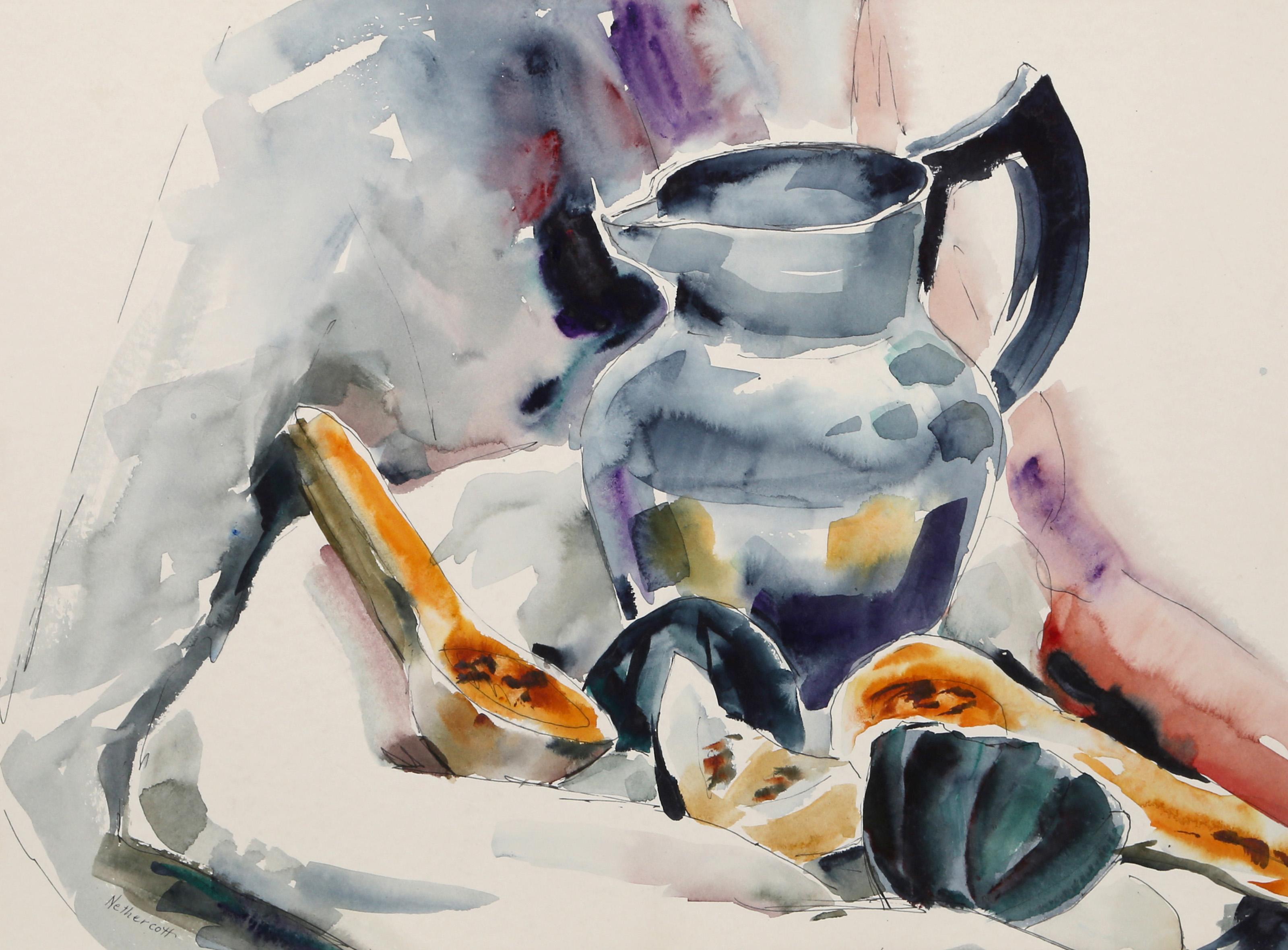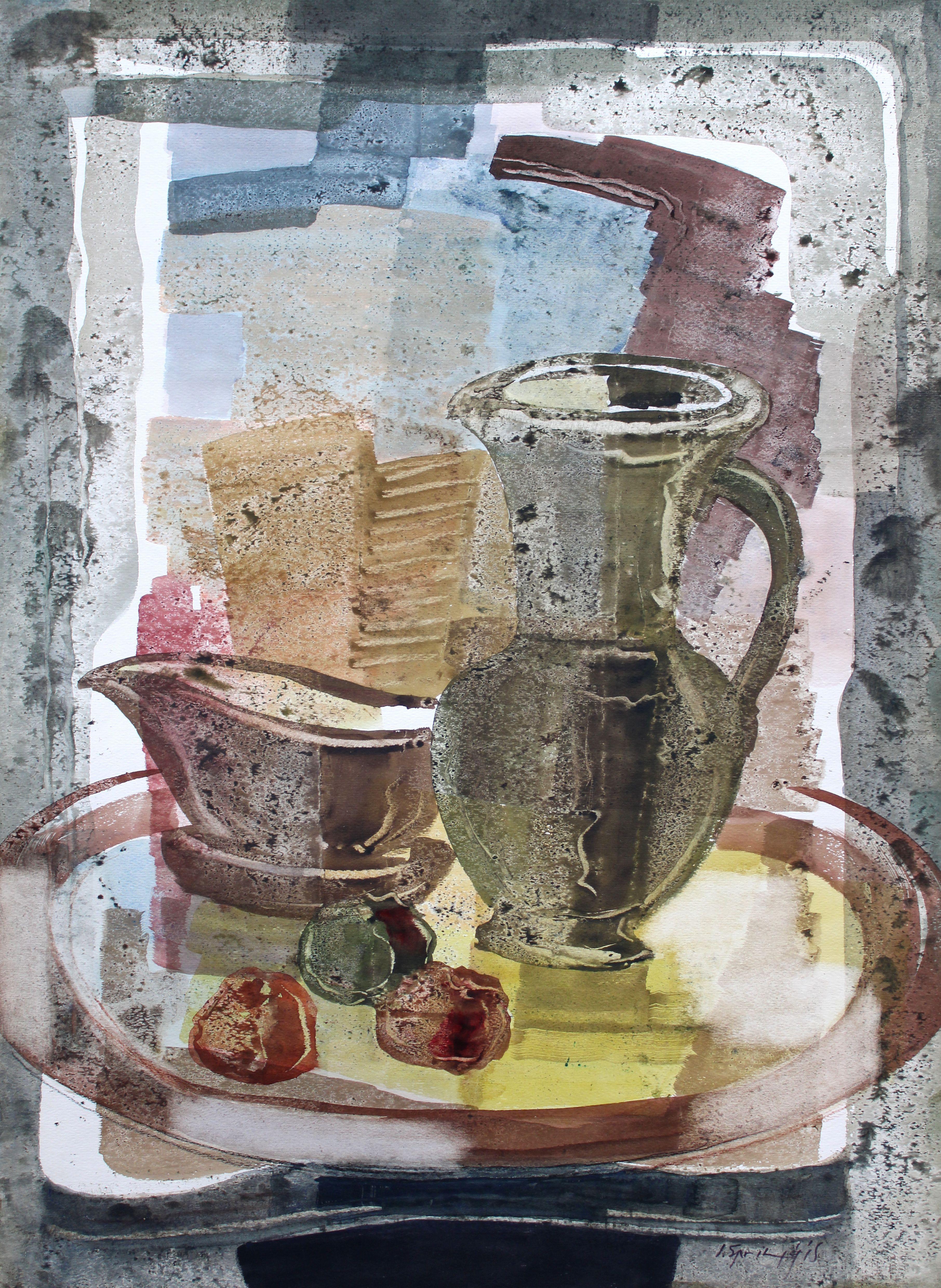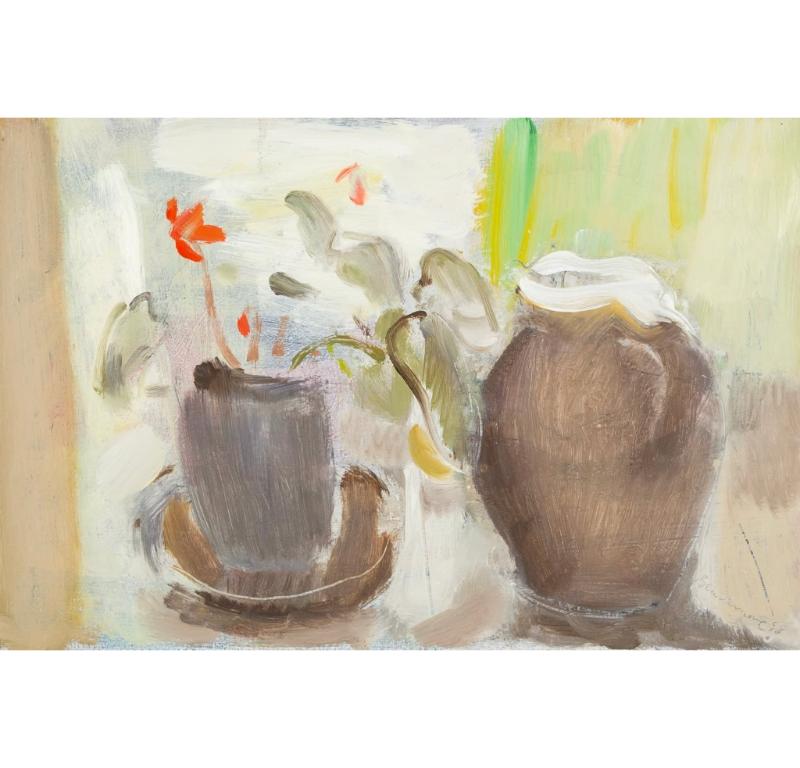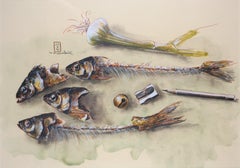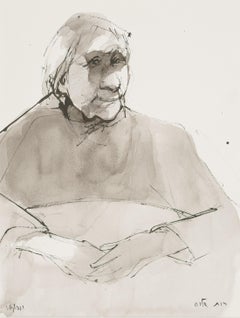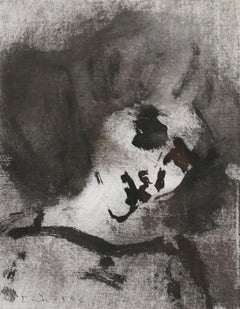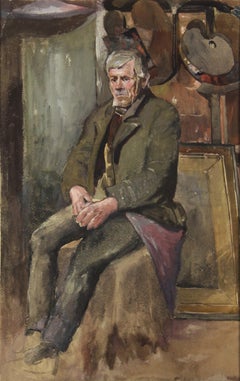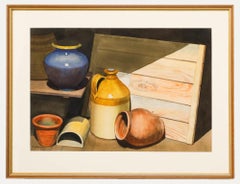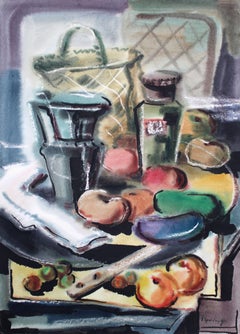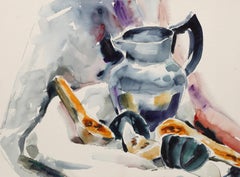Items Similar to Clay jug on a bench - The essence of the clay jar revealed by the sunlight -
Want more images or videos?
Request additional images or videos from the seller
1 of 6
Hans Richard von VolkmannClay jug on a bench - The essence of the clay jar revealed by the sunlight -1890
1890
$814.08
$1,017.6020% Off
£600.51
£750.6420% Off
€680
€85020% Off
CA$1,127.95
CA$1,409.9320% Off
A$1,223.99
A$1,529.9920% Off
CHF 648.61
CHF 810.7620% Off
MX$15,011.69
MX$18,764.6220% Off
NOK 8,026.49
NOK 10,033.1120% Off
SEK 7,584.61
SEK 9,480.7620% Off
DKK 5,178.07
DKK 6,472.5920% Off
About the Item
Hans Richard von Volkmann (1860 Halle (Saale) - 1927 ibid.), Clay jug on a bench. Pencil and Watercolour on paper. 20 x 26,7 cm (visible size), 37 x 45 cm (frame), dated and monogrammed lower left "Februar 1890 - HR. V. V."
- Minimally tanned. Framed behind glass in a passepartout.
About the artwork
Using the technique of his early youth - pencil and watercolour - Hans Richard von Volkmann depicts a still life. However, this is not a conventional indoor still life, but an open-air depiction, painted outdoors and not in the studio. It is therefore an open-air painting, characteristic of von Volkmann's oeuvre, which could have been painted in the Willingshausen colony of painters, where open-air painting was programmatically practised there and the artist stayed there that year.
And indeed, this painting is a manifesto of open-air painting. Von Volkmann demonstrates that leaving the studio for the light of nature leads to an entirely new quality of art. To prove this, he uses the genre of still life, which can be described as the studio subject par excellence. Moreover, light plays an essential role in the classical still life. It is the real protagonist of the still life. And it is precisely this moment, essential to the still life, that von Volkmann exploits to demonstrate the potential of plein-air painting: He presents the objects as they appear in the sunlight. The date of February and the bare branches in the foreground make it clear that this is a clear winter day in bright sunlight. The delicate plant in the foreground casts a clearly defined shadow, as does the jug. However, the shadow is most pronounced on the jug itself: The underside of the handle appears almost black, making the top, and therefore the jug itself, shine all the more brightly. The shining of the objects in the sunlight is also visible on the bench. As complementary phenomena to the shadow zones, light edges can be seen on the boards of the seats and the upper foot of the bench shines entirely in the light. To achieve this intensity of light, von Volkmann activated the bright white of the painting ground.
By depicting the objects in glistening sunlight, von Volkmann demonstrates that this quality of light is only to be found outdoors. And this light leads to a new way of looking at the objects themselves. The jug on the bench seems like an accidental arrangement, as if the artist had stumbled upon this unintentional still life and captured it with fascination. And in this fascination there is a moment of realisation that refers to the objects themselves. It is only when they shine brightly in the sunlight that their true nature is revealed. In this way, sunlight allows the objects to come into their own, so to speak. Sunlight, which is not present in the studio, gives the still life an entirely new dimension of reality, which is also reflected in the colours interwoven by the sunlight: The bench and the jug stand in a harmonious grey-pink contrast to the green of the implied meadow.
The emphasis on the jug as the central subject of the picture also implies that the watercolour has not been completed. This non finito inscribes a processuality into the picture, making it clear that something processual has been depicted, the temporality of which has been made artistically permanent. This is why von Volkmann signed the painting and dated it to the month.
About the Artist
Von Volkmann made his first artistic attempts at the age of 14. He painted many watercolours of his home town of Halle. This laid the foundation for his later outdoor painting.
In 1880 his autodidactic beginnings were professionalised with his admission to the Düsseldorf Art Academy. There he studied under Hugo Crola, Heinrich Lauenstein, Johann Peter Theodor Janssen and Eduard von Gebhardt until 1888. Von Volkmann then moved to the Karlsruhe Academy, where he was Gustav Schönleber's master pupil until 1892.
In 1883 he came for the first time to Willingshausen, Germany's oldest painters' colony, at the suggestion of his student friend Adolf Lins. He was to return to Willingshausen again and again over the next 25 years, even living there for a time to devote himself entirely to open-air painting.
Von Volkmann soon became a much sought-after landscape painter, and his works found their way into German museums. He became a professor in 1902 and a member of the board of the Deutscher Künstlerbund from 1906. Through his father, Richard von Volkmann, he also had an affinity for book illustration. Under the pseudonym Richard Leander, his father had published 'Träumereien an französischen Kaminen' (Dreams at French Chimneys), first published in 1871, which his son illustrated, among many other works.
"Over the years, he enriched his realist and naturalist means of artistic expression with influences from Art Nouveau and other modern trends, and was able to transform objective observations of nature into subjective atmospheric images".
- Heinz Bischof
Selection of exhibitions
1928 - Gedächtnisausstellung mit dem Frühwerk Hans von Volkmanns, Halle a. S.
2021 - Hans Richard von Volkmann. Landschaften, Kunsthalle in Willingshausen.
Selected Bibliography
Dorit Litt: Das künstlerische Schaffen des Landschaftsmalers Hans Richard von Volkmann, 1860 - 1927, Bonn 1996.
Bernd Küster: Hans von Volkmann, Bremen 1998.
Thank you for your interest! I hope I have been able to explain to you the special character of the artwork. If you have any questions of any kind, please feel free to contact me.
I wish you many more discoveries in the realm of art,
Dr Martin Kirves
GERMAN VERSION
Hans Richard von Volkmann (1860 Halle (Saale) – 1927 ebd.), Tonkrug auf einer Bank im Sonnenlicht. Bleistift und Aquarell auf Papier, 20 x 26,7 cm (Sichtmaß), 37 x 45 cm (Rahmen), Datiert und monogrammiert unten links „Februar 1890 - HR. V. V.“
- Minimal nachgedunkelt. Hinter Glas im Passepartout gerahmt.
Exposé als PDF
zum Werk
In der Technik seiner frühesten Jugendzeit – Bleistift und Aquarell – veranschaulicht Hans Richard von Volkmann ein Stillleben. Es ist aber kein herkömmliches Stillleben in einem Innenraum, sondern eine in der freien Natur angesiedelte Darstellung, die zudem im Freien und nicht im Atelier entstanden ist. Es handelt sich also um eine für von Volkmanns Oeuvre charakteristische Freilichtmalerei, die in der Malerkolonie Willingshausen geschaffen worden sein könnte, da die Freilichtmalerei dort programmatisch betrieben wurde und sich der Künstler in diesem Jahr dort aufgehalten hat.
Und tatsächlich steht mit diesem Bild ein Manifest der Freilichtmalerei vor Augen. Von Volkmann demonstriert, dass der Gang aus dem Atelier ins Licht der Natur zu einer ganz neuen Qualität der Kunst führt. Um diesen bildlichen Beweis anzutreten, stellt er den Bezug zum Genre des Stilllebens her, das als Ateliersujet schlechthin bezeichnet werden kann. Zudem spielt beim Stillleben klassischer Art das Licht eine ganz wesentliche Rolle. Es ist der eigentliche Akteur des Stilllebens. Und gerade diesen für das Stillleben wesentlichen Moment arbeitet von Volkmann heraus, um das Potenzial der Freilichtmalerei aufzuzeigen: Er präsentiert die Gegenstände, wie sie sich im Sonnenlicht darbieten. Die Datierung auf den Februar und die kahlen Äste im Vordergrund verdeutlichen, dass es sich um einen klaren Wintertag im strahlenden Sonnenlicht handelt. Das zierliche Gewächs im Vordergrund wirft ebenso wie der Krug einen klar konturierten Schlagschatten. Am deutlichsten ist der Schattenwurf aber am Krug selbst ausgeprägt: Die Unterseite des Henkels mutet beinahe Schwarz an, wodurch die Oberseite und mit ihr der Krug selbst umso heller aufstrahlt. Das Aufstrahlen der Gegenstände im Sonnenlicht wird auch bei der Bank sichtbar. Als Komplementärphänomene zu den Schattenzonen sind an den Brettern der Sitzflächen Lichtkanten zu sehen und der obere Fuß der Bank strahlt gänzlich im Licht auf. Für diese Lichtintensität aktiviert von Volkmann das helle Weiß des Malgrundes.
Durch die Darstellung der Gegenstände im gleißenden Sonnenlicht führt von Volkmann bildnerisch vor, dass eben diese Lichtqualität nur im Freien präsent ist. Und dieses Licht führt zu einer neuen Sicht auf die Gegenstände selbst. Der Krug auf der Bank wirkt wie ein zufälliges Arrangement, als ob der Künstler des Weges kam, diesem nicht intendierten Stillleben ansichtig wurde und es voller Faszination festhielt. Und dieser Faszination wohnt ein Erkenntnismoment inne, der sich auf die Gegenstände selbst bezieht. Erst ihr helles Aufstrahlen im Sonnenlicht offenbart ihr eigentliches So-Sein. Damit lässt das Sonnenlicht die Gegenstände gewissermaßen zu sich selbst kommen. Durch das im Atelier nicht gegebene Sonnenlicht erhält das Stillleben folglich eine ganz neue Realitätsdimension, die sich auch in den vom Sonnenlicht durchwirkten Farben niederschlägt: Die Bank und der Krug stehen in einem harmonischen Grau-Rosa-Kontrast zueinander, der vom Grün der angedeuteten Wiese hinterfangen wird.
Zur Hervorhebung des Kruges als zentralem Bildgegenstand gehört auch, dass das Aquarell nicht vollständig ausgeführt worden ist. Dieses non finito schreibt dem Bild eine Prozessualität ein, die verdeutlicht, dass etwas Prozesshaftes dargestellt worden ist, dessen Temporalität künstlerisch auf Dauer gestellt wurde. Daher hat von Volkmann das Bild signiert und auf den Monat genau datiert.
zum Künstler
Bereits als 14jähriger unternahm von Volkmann erste künstlerische Versuche. In einer Vielzahl von Aquarellen stellte er seine Hallenser Heimat dar. Dies legte die Grundlage für seine spätere Freilichtmalerei.
1880 wurden die autodidaktischen Anfänge mit der Aufnahme in die Düsseldorfer Kunstakademie professionalisiert. Dort studierte er bis 1888 bei Hugo Crola, Heinrich Lauenstein, Johann Peter Theodor Janssen und Eduard von Gebhardt. Anschließend wechselte von Volkmann an die Akademie Karlsruhe, um dort bis 1892 Meisterschüler von Gustav Schönleber zu werden.
1883 kam er auf Anregung seines Studienfreundes Adolf Lins erstmals nach Willingshausen, der ältesten Malerkolonie Deutschlands. Über 25 Jahre hinweg sollte er immer wieder dorthin zurückkehren und zeitwiese auch dort wohnen, um sich ganz der Freilichtmalerei zu widmen.
Schnell wurde von Volkmann zum gefragten Landschaftsmaler, der Einzug in die deutschen Museen hielt. 1902 wurde er Professor und ab 1906 war er Vorstandsmitglied des Deutschen Künstlerbundes. Durch seinen Vater, Richard von Volkmann, hatte er zudem eine Affinität zur Buchillustration. Unter dem Pseudonym Richard Leander hatte der Vater die vielfach aufgelegten, erstmals 1871 erschienenen „Träumereien an französischen Kaminen“ veröffentlicht, die sein Sohn – unter einer Vielzahl anderer Werke – illustrierte.
„Seine am Realismus und Naturalismus geschulten künstlerischen Ausdrucksmittel bereicherte er im Lauf der Jahre durch Einflüsse des Jugendstils sowie anderer moderner Tendenzen und verstand es, objektive Naturbeobachtung in subjektive Stimmungsbilder zu überführen.“
- Heinz Bischof
Auswahl an Einzelausstellungen
1928 - Gedächtnisausstellung mit dem Frühwerk Hans von Volkmanns, Halle a. S.
2021 - Hans Richard von Volkmann. Landschaften, Kunsthalle in Willingshausen
Auswahlbibliographie
Dorit Litt: Das künstlerische Schaffen des Landschaftsmalers Hans Richard von Volkmann, 1860 - 1927, Bonn 1996.
Bernd Küster: Hans von Volkmann, Bremen 1998.
Vielen Dank für Ihr Interesse! Ich hoffe, ich habe Ihnen den besonderen Charakter des Kunstwerks näherbringen können. Bei Fragen jeglicher Art können Sie mich gerne kontaktieren.
Ich wünsche Ihnen noch viele Entdeckungen im Reich der Kunst,
Dr. Martin Kirves
- Creator:Hans Richard von Volkmann (1860 - 1927, German)
- Creation Year:1890
- Dimensions:Height: 7.88 in (20 cm)Width: 10.52 in (26.7 cm)
- Medium:
- Movement & Style:
- Period:
- Condition:
- Gallery Location:Berlin, DE
- Reference Number:1stDibs: LU2438212305762
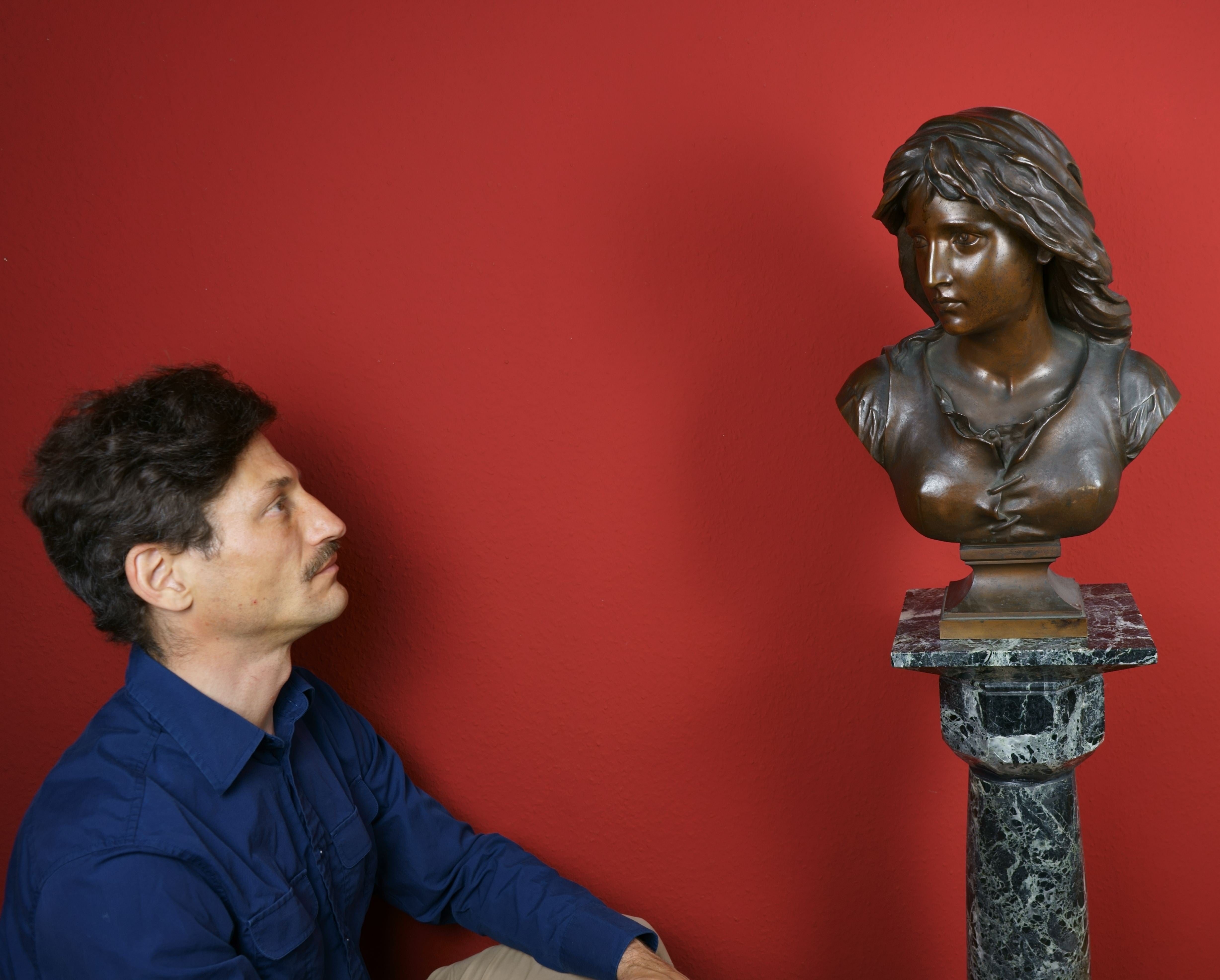
About the Seller
5.0
Vetted Professional Seller
Every seller passes strict standards for authenticity and reliability
Established in 2014
1stDibs seller since 2023
21 sales on 1stDibs
- ShippingRetrieving quote...Shipping from: Berlin, Germany
- Return Policy
Authenticity Guarantee
In the unlikely event there’s an issue with an item’s authenticity, contact us within 1 year for a full refund. DetailsMoney-Back Guarantee
If your item is not as described, is damaged in transit, or does not arrive, contact us within 7 days for a full refund. Details24-Hour Cancellation
You have a 24-hour grace period in which to reconsider your purchase, with no questions asked.Vetted Professional Sellers
Our world-class sellers must adhere to strict standards for service and quality, maintaining the integrity of our listings.Price-Match Guarantee
If you find that a seller listed the same item for a lower price elsewhere, we’ll match it.Trusted Global Delivery
Our best-in-class carrier network provides specialized shipping options worldwide, including custom delivery.More From This Seller
View AllStill life with fish bones, pencil and pencil sharpener / - The irony of art -
Located in Berlin, DE
Manfred K. Schwitteck (*1948), Still life with fish bones, pencil and pencil sharpener, 1992. watercolor over pencil on handmade paper, 31.5 x 45 cm (visible size), 47 x 61 cm (frame...
Category
1990s Surrealist Still-life Drawings and Watercolors
Materials
Etching, Watercolor
Old Woman at the Table / - Shaded view -
By Ruth Schloss
Located in Berlin, DE
Ruth Schloss (1922 Nuremberg - 2013 Kfar Shmaryahu), Old Woman at the Table, around 1990. Mixed media on watercolor paper, 32 cm x 24 cm, signed “Schloss” lower left and signed again...
Category
1990s Realist Figurative Drawings and Watercolors
Materials
Paper
Woman's head / - Female Wisdom -
Located in Berlin, DE
Emil Wachter (1921 Neuburgweiser - 2012 Karlsruhe), Woman's head, 1986. Drawing in ink on canvas, 24.5 cm x 19 cm (sheet size), 44.5 cm x 36.4 cm (frame), signed ‘E. Wa[achter]’ lowe...
Category
1980s Realist Figurative Drawings and Watercolors
Materials
Paper
Man sitting in the studio - Thinking about art -
Located in Berlin, DE
Adolph Eduard Otto von Faber du Faur (1828 Ludwigsburg - 1901 Munich). Man sitting in the studio. Watercolour painting, 43 x 27 cm (visible size), 73 x 53 cm (frame), monogrammed at lower right, estate stamp.
Upper right corner neatly repaired, small tear in the wall to the left of the sitter.
- Thinking about art -
About the artwork
The sitter, an elderly man, is seated in a studio on a pedestal reminiscent of an academy hall. The earthy, dark tones give the scene a weighty quality. The lightest tones are found in the incarnate parts of the figure, which do not stand out from the other colours of the picture, but are linked to them. As a result, the sitter's face is both part of and the highlight of the colour references in the picture. The colour of the sitter's skin is reflected in his pink coat, while his white-grey hair matches the colour of the wall next to him. This almost monochrome wall surface, in turn, is connected across the portrait to the framed picture standing on the floor, which seems to have been erased by this correspondence with the empty wall surface. Through the palette, which is positioned directly behind the sitter's head, the reference to painting, which is already given by the studio space, is explicitly linked to the sitter, who thus seems to be contemplating the question of the meaning of art.
This raises the question of whether Faber Du Faur, who had become lonely in his old age, might have painted a self-portrait here in his later years. In addition to the studio setting, the sitter's explicit reference to the palette and the fact that the picture was part of his estate, the only summary elaboration of the body suggests a self-portrait, while the representation of the face is concretised with the wide-open eyes typical of a self-portrait. This concentration on the face gives the impression of the artist's melancholy introspection, captured by the palette and related to the meaning of painting, whose dark character is reinforced by the concealment of the palette hanging on the right of the picture in the light tones so characteristic of Faber Du Faur. In the course of this resignation, Faber du Faur advises his son Hans, who has also become a painter: "Promise me one thing: never move to Munich, they'll kill you here!"
Whoever the sitter may be, the references to painting make the portrait a resigned self-contemplation by Faber Du Faur, focused on art.
About the artist
After leaving school, Otto Faber du Faur entered the service of the Württemberg army, at the same time cultivating his artistic talent. In 1851, on the recommendation of his father Christian Wilhelm, who was himself a battle painter, he spent six months in Munich as an apprentice to Alexander von Kotzebue. In 1852 he was granted a year's leave of absence from military service to study battle painting in the studio of Adolphe Yvon...
Category
1890s Realist Portrait Drawings and Watercolors
Materials
Watercolor
$909 Sale Price
20% Off
Two sitting old people / - Familiar Strangeness -
By Ruth Schloss
Located in Berlin, DE
Ruth Schloss (1922 Nuremberg - 2013 Kfar Shmaryahu), Two sitting old people, around 1990. Mixed media on watercolor paper, 24 cm x 32 cm, signed “Schloss” lower left and again in Heb...
Category
1990s Realist Figurative Drawings and Watercolors
Materials
Paper
Female Nude Sitting on a Sofa
Located in Berlin, DE
Wilhelm Trübner (1851 Heidelberg - 1917 Karlsruhe), Female Nude Sitting on a Sofa, around 1900. Pencil drawing, 32.5 x 48.5 cm, monogrammed “W.T.” lower left and inscribed on the rev...
Category
Early 1900s Realist Nude Drawings and Watercolors
Materials
Paper
You May Also Like
W. G. Roberts - Mid 20th Century Watercolour, Still Life with Stoneware Jug
By William Goodridge Roberts 1
Located in Corsham, GB
A busy still life scene depicting various pottery items on a wooden bench top, centred by a large stoneware jug. Well presented in a slim wooden frame. Signed in the lower left and d...
Category
20th Century Still-life Drawings and Watercolors
Materials
Watercolor
Mug on a tray. 1970s, paper, watercolor, 76x55 cm
Located in Riga, LV
Mug on a tray. 1970s, paper, watercolor, 76x55 cm
Jekabs Arturs Springis
(1907– 2004) Painter, Latvia
1924 – 1927 – he learned at Aizpute Secondary School
1927 – 1930 – learning ...
Category
1970s Impressionist Still-life Drawings and Watercolors
Materials
Paper, Watercolor
Still life with a basket 1970's, watercolor on paper, 76x55 cm
Located in Riga, LV
Still life with a basket 1970's, watercolor on paper, 76x55 cm
Jekabs Arturs Springis
(1907– 2004) Painter, Latvia
1924 – 1927 – he learned at Aizpute Secondary School
1927 – 19...
Category
1970s Impressionist Still-life Drawings and Watercolors
Materials
Paper, Watercolor
Still Life with Pitcher, Impressionist Watercolor by Eve Nethercott
By Eve Nethercott
Located in Long Island City, NY
Eve Nethercott, American (1925 - 2015) - Still Life with Pitcher (P4.4), Year: 1960, Medium: Watercolor on Paper, Size: 13.5 x 18 in. (34.29 x 45.72 cm), Description: Bathed ...
Category
1960s Impressionist Still-life Drawings and Watercolors
Materials
Watercolor
Still life with tray 1980's, watercolor on paper, 75x55 cm
Located in Riga, LV
Still life with tray. 1980's, watercolor on paper, 75x55 cm
Jekabs Arturs Springis
(1907– 2004) Painter, Latvia
1924 – 1927 – he learned at Aizpute Secondary School
1927 – 1930 –...
Category
1980s Impressionist Still-life Drawings and Watercolors
Materials
Paper, Watercolor
Still Life with Earthenware Jug by Clive Blackmore, 1998, Oil Painting
Located in Kingsclere, GB
Still Life with Earthenware Jug, Oil on Canvas Laid on Board Painting, 1998
Additional information:
Medium: Oil on canvas laid on board
25.5 x 38 cm
10 x 15 in
Signed and dated; als...
Category
20th Century Still-life Paintings
Materials
Canvas, Oil
